Since 2018 Anna Dumitriu held an artist in residence post with the National Collection of Type Cultures, the oldest and most historic collection of pathogenic organisms. She is developing a new body of work with the collection, telling stories and drawing threads between the history and future of microbiology. New works so far developed with the NCTC include “Clean Linen” and “The Plague Dress“.
As part of Anna Dumitriu artist’s residency with the National Collection of Type Cultures (NCTC), the oldest and most historic collection of important pathogenic bacteria in the world she has worked with the collection to add the first artistically important pathogen into the collection. The Staphylococcus aureus bacteria cultured from Anna Dumitriu’s own body, whole genome sequenced by the artist and used in numerous artworks in the first organism to be accessioned by the National Collection of Type Cultures so that it may be saved for posterity, and used in future research or artistic projects. Dumitriu undertook the entire process of preserving the organism herself fully supervised by an expert. Following the NCTCs rigorous quality control process the bacterium is now available under code number NCTC 14139.
Dumitriu worked with the NCTC at the UK Health Security Agency (formerly Public Health England) in Colindale, London to undertake the entire process hands on herself, to learn what is involved in preserving a bacteria for the future. NCTC 14139 is available from the collection for researchers to work with and the whole genome sequence of this penicillin resistant organism can also be supplied as it was previously sequenced hands on by the artist in collaboration with Kevin Cole and Professor John Paul with Modernising Medical Microbiology. Dumitriu said: “I hope that BioArtists as well as scientists of the future will be able to work with my Staphylococcus aureus from an art historical perspective as well as a scientific one”. Dumitriu’s bacterium is not the first in the collection to be sampled from the body of the person donating it. The collection already has a bacterium that Alexander Fleming took from his own body. The act of certifying this bacterium as an artistic medium is also reminiscent of the 20th Century artist Yves Klein’s act of registering his trademark shade of blue: International Klein Blue (IKB), however in the spirit of contemporary Open Source culture, so important in the practice of bio-hacking, NCTC 14139 is now available to anyone who can prove they are able to work safely with a Biosafety Level 2 pathogen.
About the National Collection of Type Cultures
NCTC supplies reference bacterial cultures of medical, scientific and veterinary importance worldwide. The cultures include many type strains (these are the organisms to which other strains are compared with to know whether they belong to that same species or not). NCTC strains support academic, health, food and veterinary institutions and are used in microbiology laboratories in a range of different sectors and in research institutes worldwide. Founded in 1920, NCTC is the longest-established collection of its type anywhere in the world, and also serves as a United Nations Educational, Scientific and Cultural Organization (UNESCO) Microbial Resource Centre (MIRCEN). The certified collection comprises over 5,000 bacterial cultures, all of which are available in a freeze-dried format.
The Process of Adding Dumitriu’s Bacteria to the National Collection of Type Cultures
Since becoming NCTC artist in residence Dumitriu felt it was important to fully understand the work, processes and needs to the collection. It is very important to the NCTC that scientists continue to donate their strains to the collection and Dumitriu decided that she would performatively add her own strain to the collection to learn what exactly is involved and share what goes on in the collection more widely. Initially she tried to add her CRISPR modified “Make Do and Mend” strain to the collection but as it was created using a proprietary strain of Top Ten E. coli this proved not to be possible (bacteria in the collection need to be able to be supplied to researchers at a small cost by the NCTC), so she hit on the idea of using the Staphylococcus aureus from her own body (used in many of her works) instead. As the strain has already been whole genome sequenced (for artistic purposes) Dumitriu has been able to work with it in multiple labs and often researchers in those places had (unexpectedly from Dumitriu’s perspective) begun to use the strain for their own research, such as Dumitriu’s experience at the University of York as part of her “Hunt for New Antimicrobials” project with Professor Maggie Smith.
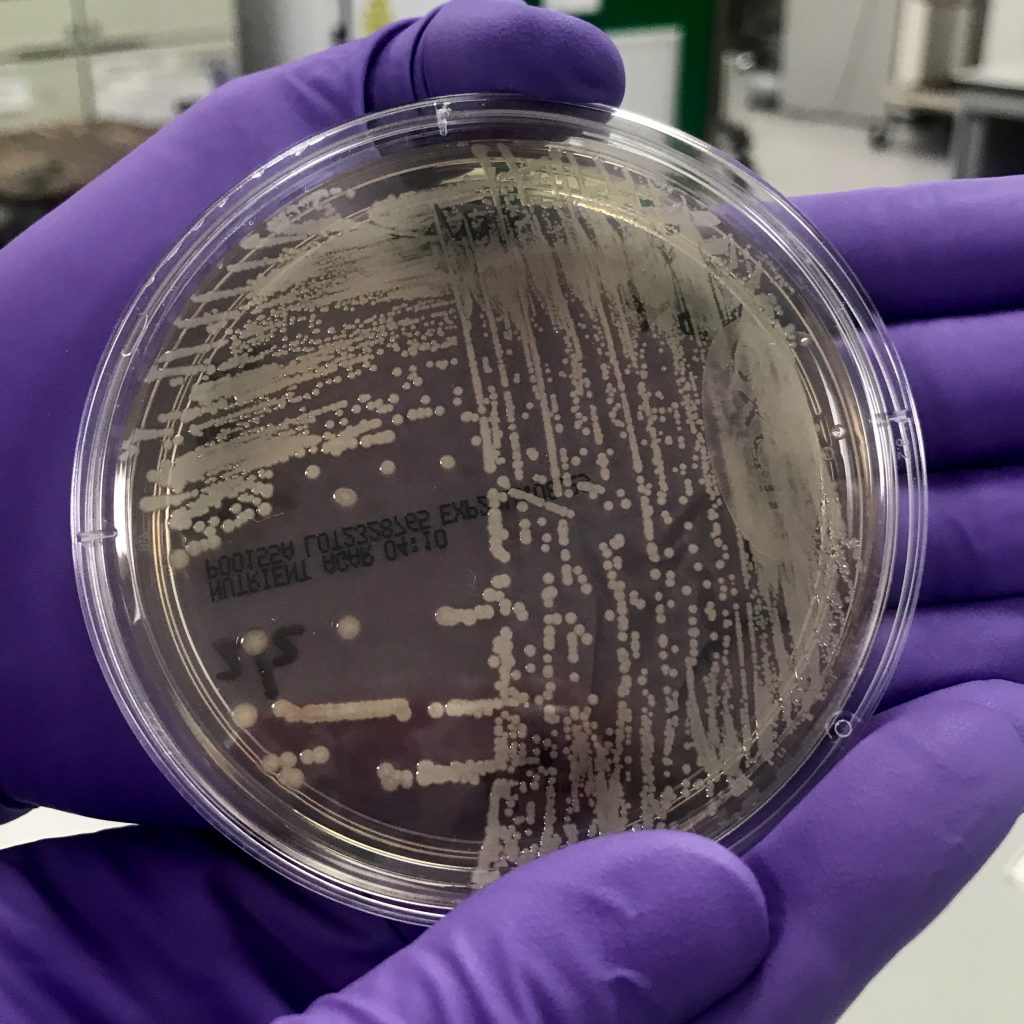
Anna Dumitriu and her collaborator Public Health England Biomedical Scientist Kevin Cole from Modernising Medical Microbiology completed an NCTC for donating the bacterium to the collection. The bacterium, was then sent to the NCTC and grown in culture.

It was grown on a special agar growth media that causes Staphylococcus aureus to grow black in order to check for contamination. The bacteria was also grown on nutrient agar on several plates in order to produce sufficient bacteria for the freeze drying process.
The bacteria was collected on a large loop using the technique shown and placed in a Falcon tube with inositol serum broth, which helps to protect the bacteria throughout the freezing and subsequent drying process so they remain alive (viable). The bacterial suspension was mixed by vortexing.

150 micro litres of bacteria were distributed into 1 of 40 pre-labelled, autoclaved ampules and and placed in a vented container for freeze drying. The container was placed in the freeze dryer.
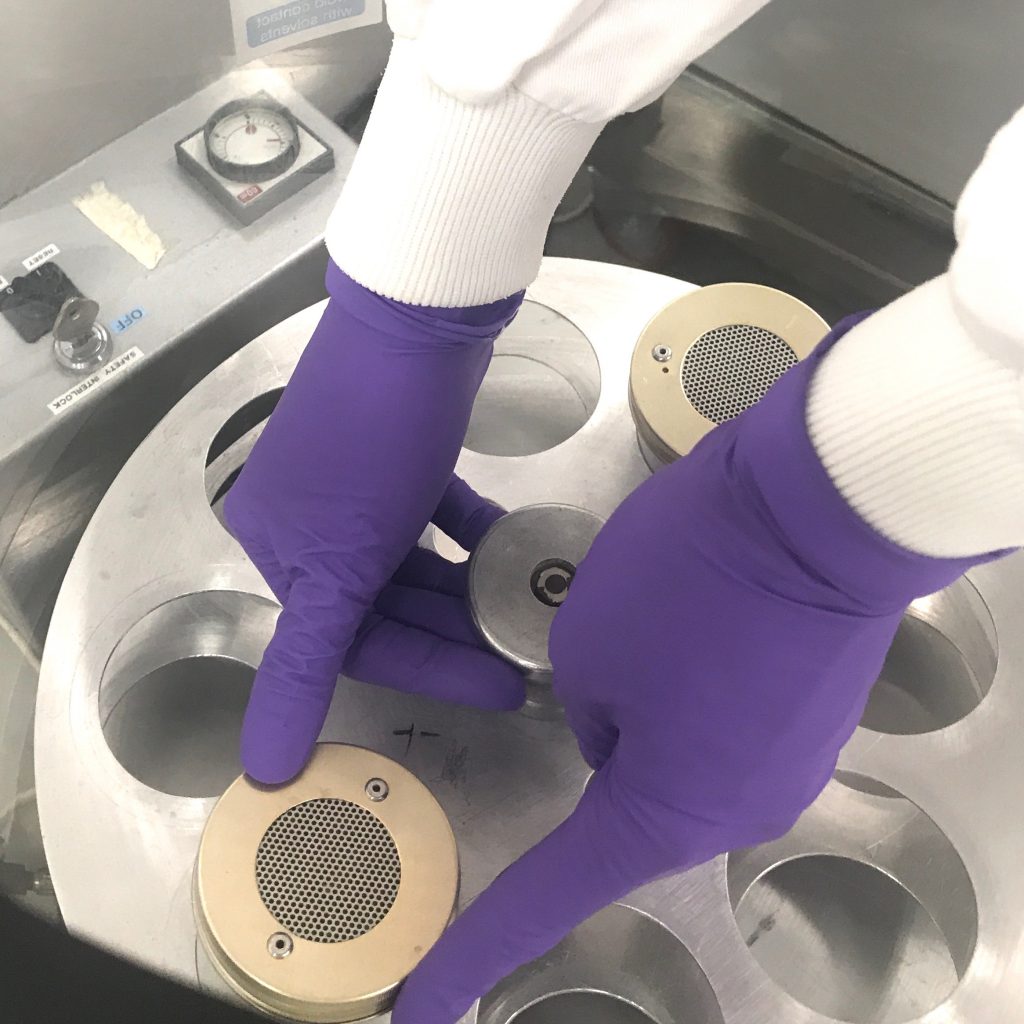
The freeze dryer spins the tubes removing almost all the moisture. After three hours the ampules could be removed with the freeze dried bacteria contained inside.
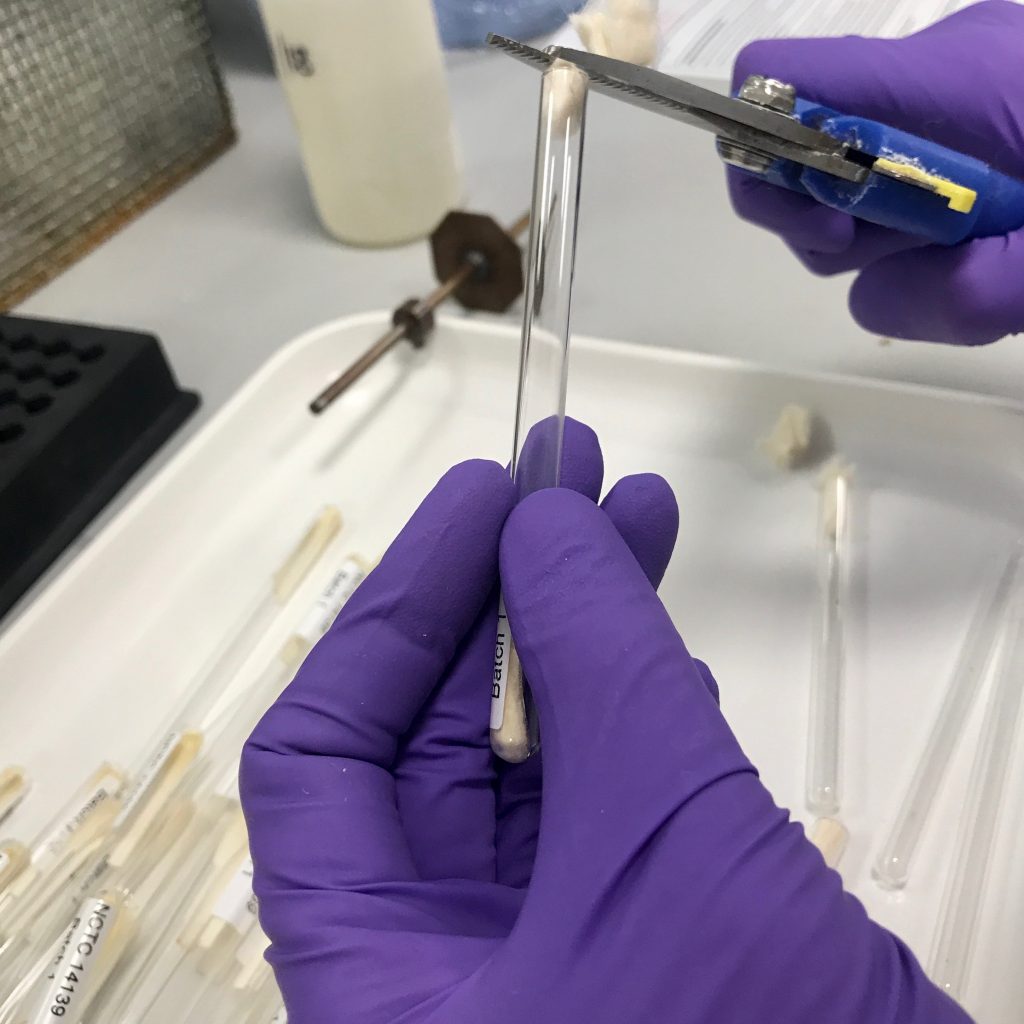
The tubes were sealed gently with sterilised cotton wool, which was trimmed off and pushed part of the way down the tube (so as to not touch the bacteria). The ampules were heated and twisted to semi-seal them. The ampules are placed on a machine which vacuum seals the tubes and removes the very last of the moisture possible.
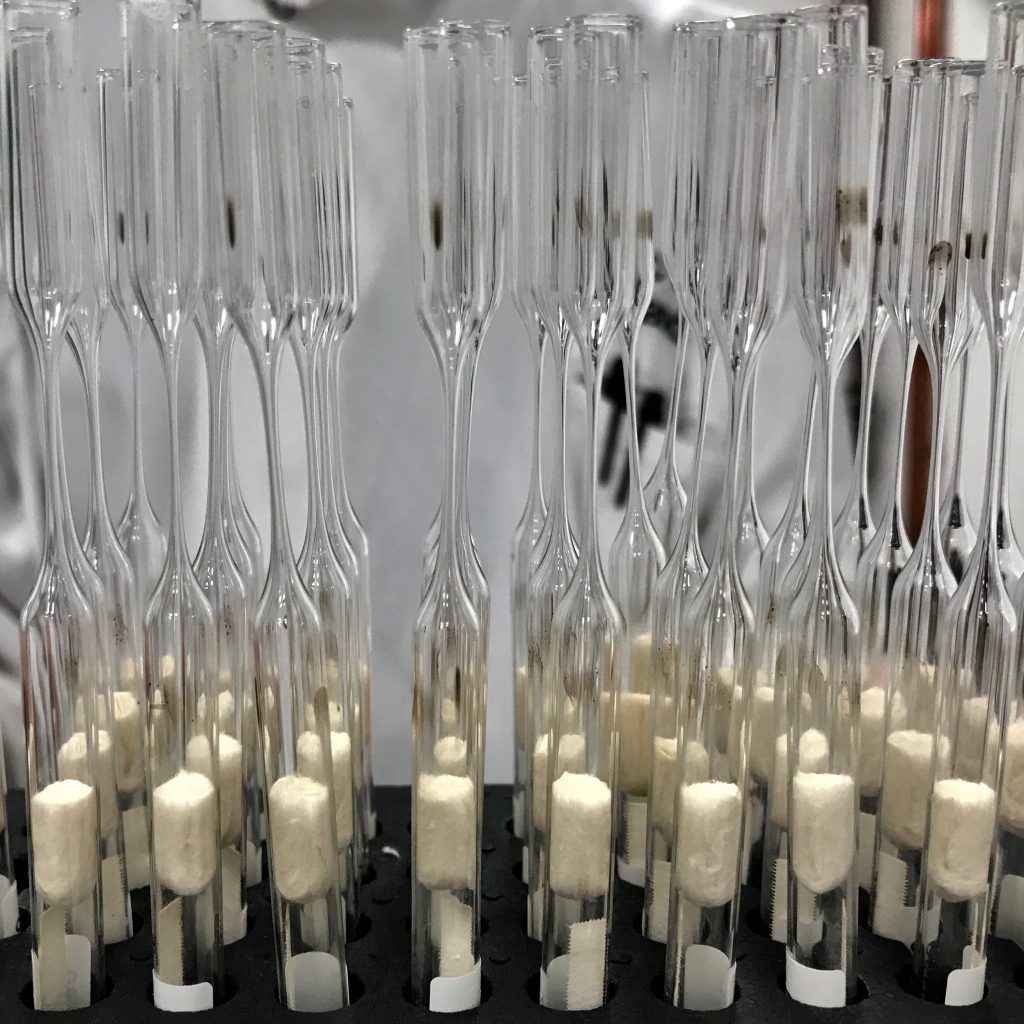
The vacuum is tested using electricity and a flash of lightning is observed, proving the vacuum is intact. If no flash is observed then the ampule is discarded. Every aspect of the process is entered into a computer system so everything is fully traceable.
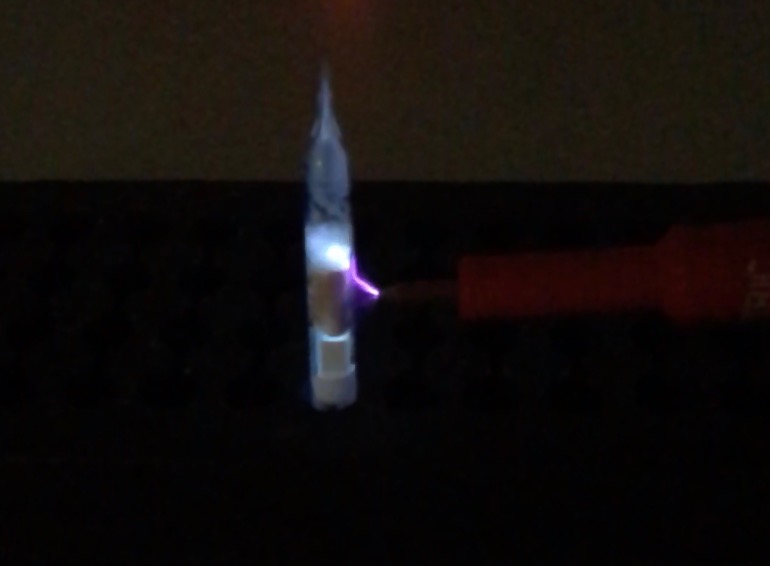
Finally some ampules are tested by the Quality Control lab who check that the bacterium is exactly what it should be. The first dilute the bacteria to a predetermined state of turbidity (cloudiness).

